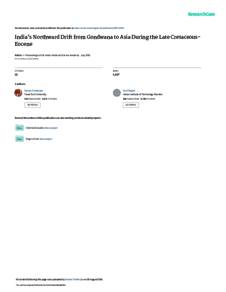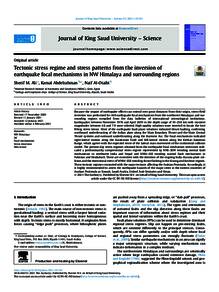Document
India's northward drift from Gondwana to Asia during the late cretaceous-eocene.
Identifier
DOI: 10.16943/ptinsa/2016/48462
Contributors
Bajpai, Sunil., Author
Publisher
Indian National Science Academy.
Gregorian
2016-07
Language
English
English abstract
The northward drift of the Indian plate from its original Gondwana home in the late Jurassic to its current position in Asia since the Early Cenozoic provides a unique natural laboratory for tracking its changing geography, climate, tectonics, and biotic evolution for the past nearly 150 million years. With the breakup of Gondwana, India began to disintegrate into a smaller plate, becoming partially isolated during the Early Cretaceous Period, but possibly retaining a biotic link with Africa via Madagascar. Around 80 Ma, as the Indian plate collided with the Kohistan-Ladakh (KL) Arc and Arabia collided with the Oman Arc, a continuous accreted terrane - the Oman-Kohistan-Ladakh (OKL) Arc- was formed that possibly served as a biotic filter bridge between India and Africa. The biotic connectivity with Africa and South America helps to resolve a major conundrum of Indian paleobiogeography, namely the lack of endemism among Late Cretaceous Indian tetrapods. Later, two catastrophic events at the Cretaceous-Paleogene (K/Pg) boundary, with possible links to the dinosaur extinction, marked the terminal phase of India's northward drift. The Deccan volcanism and the possible Shiva impact. Around the same time, Seychelles was separated from India. During the Late Cretaceous (∼67 Ma), the Indian plate suddenly accelerated its motion to 20 cm/year between two transform faults that facilitated its northward movement: The Owen-Chaman Fault on the west and the Wharton Ridge-Sagaing Fault on the east. As a result, the Neotethyan plate, bordered by these two transform faults, became a separate oceanic plate (Kshiroda plate). India continued its acceleration during the Paleocene as a passenger ship with a mobile gangplank of the OKL Arc, carrying its impoverished Gondwanan fauna. A pronounced global warming took place during the Paleocene-Eocene Thermal Maximum (PETM), when India collided with Asia causing significant changes to tectonics and tetrapod radiation. India slowed down dramatically to 5 cm/year during its initial collision, and its tetrapod fauna underwent an explosive evolution in response to a new ecological opportunity resulting in the Indo-Eurasian interchanges. The occurrence of several stem groups of tetrapods supports the Gondwanan Indian origin (i.e. the Out-of-India hypothesis) of several modern mammal orders such as the perissodactyls, primates, artiodactyls and whales whose antiquity can now be traced phylogenetically to the Indian taxa.
Member of
ISSN
0370-0046
Resource URL
Category
Journal articles


